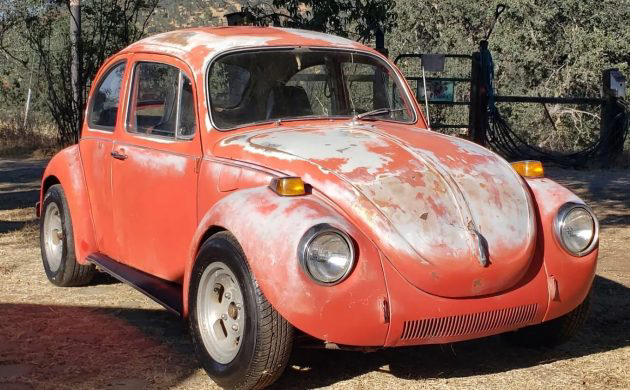No Reserve: 1972 Volkswagen Super Beetle Project
Choosing the best candidate for a project build can be challenging, but there are a lot of reasons to like this 1972 Volkswagen Super Beetle. It is a one-owner dry-climate survivor that is ideal for enthusiasts who prefer a hands-on approach. It hasn’t seen active service for years, but it is mechanically complete and comes with a selection of spare parts that will help the winning bidder on their restoration path. However, the seller’s decision to list it with No Reserve makes their auction worth monitoring if affordability is a major consideration.
The seller confirms that this Super Beetle is a one-owner classic that has spent its days in California. That helps to explain the baked Blood Orange paint, and the winning bidder will almost certainly strip this away to achieve a high-end result. However, it appears the build won’t involve much steel massaging. The panels are pretty straight, and the underside shots confirm the presence of nothing beyond dry surface corrosion. With no visible steel penetration, the grinder and welder can remain safely tucked away in the tool cupboard. It appears the windshield is cracked, and many of the seals have succumbed to age and UV exposure. The remaining glass is clear, and apart from the missing front bumper, the trim looks pretty respectable.
The design brief for the original Beetle was very specific, and because its developers knew that the engine would have fairly modest power, they focused on aerodynamic efficiency. This led to a decision to adopt a rear-engine philosophy, which remained a characteristic of the Beetle until the last cars rolled off the line in 2003. All engines were air-cooled flat-fours that sent the power to the road via the rear wheels. Engine capacity and power increased incrementally, with this car featuring a 1,585cc engine that produced 60hp and 87 ft/lbs of torque. Interestingly, this VW doesn’t feature the typical four-speed manual transaxle, with the owner ordering it with a three-speed “Autostick” semi-automatic unit. The car appears to be mechanically complete, although it hasn’t seen active service for many years. The engine turns freely, but with the keys now AWOL, the seller hasn’t attempted to coax it back to life. Doing so might be relatively straightforward, although factoring the cost of a mechanical refresh into the project budget would be wise.
This Super Beetle’s interior needs almost as much TLC as the exterior, with many of the vinyl surfaces showing the impact of UV exposure. It also appears the back seat base might be missing, and there is a hole in the dash where the factory radio resided. Locating replacements via the usual online auction sites shouldn’t be a problem, while the market is flooded with affordable trim kits to recapture the interior’s youthful good looks.
The 1972 Volkswagen Super Beetle hasn’t been a star performer in the classic market during the last couple of years, with values dropping slightly across the board. There is no sign of the trend reversing, but the unpredictable nature of the market means that the situation could change at any time. That means that although it is a roll of the dice, securing a solid and promising project candidate like our feature car might be strategically smart. The seller listed this solid gem here on eBay in Bakersfield, California. A single bid of $1,000 has been the only action so far, but the viewing history suggests others may join the party before the hammer falls. Will you be one of them?
Auctions Ending Soon
 2006 Ford Mustang Saleen S281 SCBid Now5 hours$16,000
2006 Ford Mustang Saleen S281 SCBid Now5 hours$16,000
 2002 Subaru Impreza WRXBid Now3 days$333
2002 Subaru Impreza WRXBid Now3 days$333
 1975 Chevrolet Corvette ConvertibleBid Now3 days$3,000
1975 Chevrolet Corvette ConvertibleBid Now3 days$3,000
 1964 Ford F-100 Camper CustomBid Now3 days$2,000
1964 Ford F-100 Camper CustomBid Now3 days$2,000
 2006 Jeep Wrangler SportBid Now5 days$10,500
2006 Jeep Wrangler SportBid Now5 days$10,500






Comments
Interesting thing about the Super Beetle is VW ditched the front torsion bars for a MacPherson strut and ball-joint suspension. Better-riding but not nearly as robust, these weren’t suitable for the Baja Bug crowd. But also, these were among the first cars to come with a diagnostic port. And early Super Beetles had the flat windshield of the older Beetles, later ones got a longer nose and a curved shield.
Terry knows his Bugs. Forget numbers matching, find a 4 speed transaxle and build yourself a robust flat 4 and this will make a very fun street car with remarkable patina.
For sure all bugs should have a four speed. I had three of them and they were so much fun. They were a tough car and simple to work on. New 1970 and 1972. Still have my have my Indy shifter with the T handle. Miss those VWS to this day.
If only it was a 1967 or 1968 actual “Type 1”, the Holy Grail.
Anyway,…
A bug should have a four speed. Had three of them. A 66 new 70 and 72 Super. They were so much fun. Still have the Indy shifter I bought for them. Miss them and my 73 z28RS 4speed to this day. Somehow the older cars were more fun.
John
The tires are “dressed”, just waiting for the rest.
How does one add the clutch cable tube when switching from auto stick shift to 4 speed? I tried to convert our 2 speed auto stick shift 69 Karmann Ghia but it lacked the clutch tube.
You might have to do some open heart surgery on the tunnel…
And after extracting the auto-stick for a replacement 4 speed, maybe market it to any volkswagen trike conversion enthusiasts that are still out there.